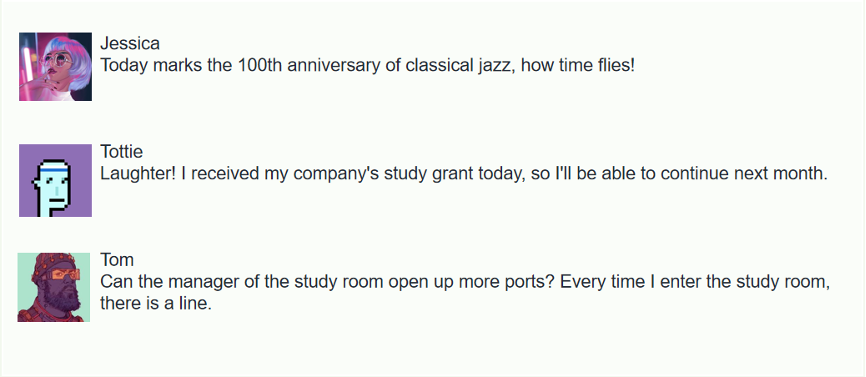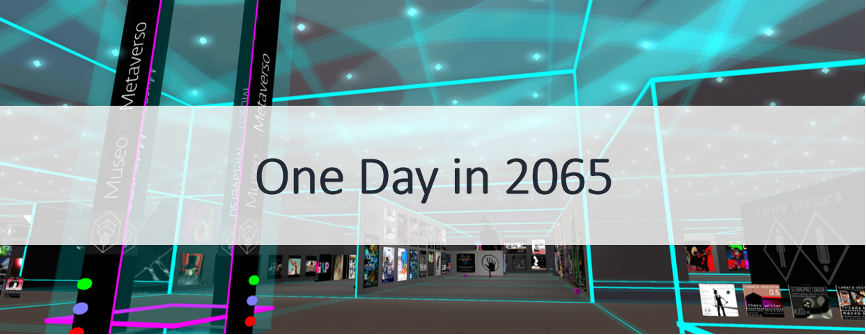“You have entered successfully.” It is time to get to work! Yesterday, the Museum of Languages attracted 100 million visitors, with adults accounting for 80% of those visitors, a 20% increase over weekdays.
My name is Meredith as an administrator working at the Language Museum. My primary task is to ensure that the AI characters are appropriately interacting with visitors. Sometimes I also occasionally assist in the collection of visitor remarks. I’ve been here since 2060, and today marks my fifth year on the job. Every day, I am happy to work at the Language Museum.
As you can see, there is a Museum of Languages in the metaverse, and there are thousands of additional museums like it. The metaverse is now literally all-powerful, and people can use VR technology to learn anything they want, like art, yoga, math, etc. The biggest reason why the metaverse has come so far is that people now understand the importance of lifelong learning. Since the 2019 covid-19 epidemic broke out, the education field has changed significantly, and digital technology has played a crucial role in this. The shift in educational strategy from traditional education to blended education, and eventually to meta-universe education, has progressed from a global experiment to a permanent measure. Now, digital technology is allowing everyone to participate in lifelong learning. Furthermore, these educational museums and galleries are supported by private and public entities, allowing anyone to access education.
Furthermore, the metaverse’s nature has provided the foundation for inclusive education. It is important to remember that fifty years ago, some excluded groups, particularly disabled individuals and impoverished children, would not have had access to such museums due to geographical and economic constraints. Fortunately, nowadays, anyone may obtain VR equipment through government funding. They also have the same right as everyone else to be educated in the metaverse.
Annually, 75% of individuals visit the Language Museum, according to data research. It is a global language education website that anyone interested in languages or wishing to learn a language can visit. More than 6,000 languages from around the world are represented here, including local dialects from various countries.
The Language Museum’s founding is noteworthy because languages have tremendous cultural value and embody the memory of an era. Sadly, many ancient languages vanished over a thousand years ago. These languages have been buried forever because of our ancestors’ lack of awareness of cultural protection and the absence of modern technology, leaving only symbols and incomplete manuscripts in caves. Later, archaeologists and historians could only translate ancient manuscripts by finding historical connections and guessing the meaning of the symbols, which made history buffs understanding past cultures incredibly difficult. According to statistics, a third of the world’s languages were spoken by fewer than 1,000 individuals fifty years ago, and half were on the edge of extinction. If not preserved, 1,500 languages could be extinct by the end of the twenty-first century, which served as a wake-up call for people to recognise the importance of language preservation in order to preserve a generation’s cultural heritage in perpetuity and to enable future generations to use language. After that, linguists have begun to use digital technology to preserve this priceless cultural heritage in order to preserve the cultural and historical heritage of one generation for all time and to assist future generations in understanding the culture and history of an era through language.
I’m standing in front of Drolma, a “Tibetan woman” from “Tibet, China.” She is clothed in traditional Tibetan attire with colourful ropes knotted in her hair, and she eagerly converses in virtual space with people from many nations. Drolma is an avatar created with 3D modelling software. Her clothes and make-up integrate all of the characteristics of the Tibetan people, and a robust language inclusion system allows her to converse in Tibetan with visitors. Visitors do not need to be concerned about language because this is the world’s largest language museum, and our AI can converse with them in any language without any obstacles. You can also talk to our AI characters about the weather, history, hobbies, and anything else that interests you. They will converse with you in the native tongue. Oh! By the way, do not be concerned if you are unfamiliar with the languages. They will all be instantly translated into language you recognise and placed on the top of your screen. There are over 1,600 more avatars like this in the Language Museum, each keeping the qualities of the local people and transmitting historical features of a time and place in a characteristic language. These sophisticated AIs, I am confident, will supply a plethora of vital knowledge to future scientists and philosophers studying the human mind. I must add that it is a very good endeavour!
Along with Choma, there are the devoted “British Royal Soldiers,” “primitive African tribal chiefs,” “Australian Aborigines,” and many others. The majority of tourists come to learn about multiculturalism through various languages. Globalization and the rapid expansion of public transportation in the last two decades have increased the rate of global mobility, and languages have begun to become more uniform. The loss of language diversity, on the other hand, has piqued the curiosity of many individuals, who are increasingly learning about history via conversing with AI. Learning above one’s ability is popular these days.
It’s nearly 5 p.m., it’s time to leave work. I cross my finger out of the staff interface and click on punch out in the bottom left corner, and everything in front of me quickly goes black, my consciousness returns to the 20-square-metre room I am accustomed to.
This room is on the 86th floor of the Meta Universe staff building in the Black River neighbourhood, where there are 30 additional rooms like it. It’s a special room for Meta Universe employees, and even though it’s just 20 square metres, it’s more than enough for me. People have become more health conscious in the last 30 years as the concept of lifelong learning has taken hold, medical discoveries have helped people overcome cancer, then people are living longer and longer lives, contributing to the population to increase. You can see here that tall buildings of 100 storeys or more can be found throughout cities, and signal towers are also common. The fact that 90% of the world’s population logs on to the metaverse world every day has increased demand for the internet. Happily, today’s 10G internet is free to use, thanks to the Metaverse Education Foundation’s donation. You may recall that due to the capitalist hijacking of the signal business a few decades ago, monthly signal fees were so exorbitant that many students from low-income families were unable to study in the metaverse because their families could not afford to pay for the internet. This is a serious breach of Article 318 of the Lifelong Learning Act, which states that “every person has the right to education in the metaverse,” as well as Article 149 of the Capital Industry Code, which states that “capitalism shall not interfere with human beings’ right to education.” As a result of the government’s participation and the assistance of private corporations and business titans, the Meta-Universe Education Foundation was founded. Since then, the internet has become an essential tool for learning.
“Ding-dong! This is Blacky, your astute butler. Your reserved dumpling set has arrived, please consume it as quickly as possible.” Blacky is still on time, and I wonder if the dumplings tasted better following the final recommendation with the catering department’s administrator. Then I remove my VR helmet and walk gently to the door, carrying the dumplings to the table after opening the door to the room.
“Oh my god, this taste!” I say with one bite, as the fresh sweet liquid wrap around the deep beef flavour, I sign with emotion. This is how my hometown tastes! My thoughts return to when I was a youngster and my mother would offer a bowl of steaming dumplings at midnight every Chinese New Year, but after working and leaving my hometown for twenty years, there was never a bowl of dumplings that reminded me of home. It’s difficult to believe that such an authentic traditional cuisine could come from the hands of a robot, but I never expect the catering department to execute it.
In truth, it is due to Lisa’s perseverance as the keeper of the intangible recipe history. She is a voracious collector of traditional recipes from around the world. She has collected 28,412 recipes of traditional cuisines from throughout the world in her 57 years in business and with a philosophy of lifelong learning, including 571 royal delicacies that have been forgotten for a thousand years. As far as I am aware, these lost recipes have been deciphered by archaeologists in ancient wall paintings and literature over the last hundred years, reproduced by gourmets numerous times, and finally entered into the Global Cloud Cookbook with the proportions of the ingredients and the cooking process, which are followed by intelligent robots.
Lisa is interested in traditional dishes as well as classic recipes. She has built a global feedback platform to learn about regional cooking, and her aides collect input on the platform on a daily basis to improve recipe localization. The concept of lifelong learning is deeply ingrained in everyone’s heart, and the collected recipes are freely available to the public to ensure that everyone has an equal share of knowledge. Everyone has free access to her cloud-based recipe platform and may use VR headsets to see and learn to prepare national cuisines in 360°. Corporate canteens can directly enter finished data into the system, and the robots will handle the cooking.
After eating, I change into my gym clothes and proceed to the 108th floor staff fitness centre. “Authenticated.” The interesting fitness pods draw my attention. Because working in the metaverse causes the body to be in a static state during work hours, the firm has meticulously created individual fitness pods for each employee, completing a fitness punch card even gets you a company subsidy. The space features a wrap-around screen, and you may manage the options with your fitness wristband. When I click the start button on the large screen, I see that the system automatically customises my fitness plan based on the total number of calories consumed (ps: the gym system is linked to the staff canteen system, and the calories of all ingredients are automatically calculated based on the recipe choices and finally transferred to the gym system. ), I click the start button, and the AI trainer on the screen begin to give out slogans. To begin the day’s warm-up, I imitate the AI’s movements. Lifelong learning has increased people’s health awareness, particularly among the elderly. Seniors have now become role models in driving fitness for all, and the daily fitness group charts clearly show that the senior group is solidly in first place.
“58, 59, 60… Great! You accomplished it!” I finally finished, and I am overjoyed to reap additional health benefits from the company. When I come home, I have a hot shower and go to bed to catch up with my pals.

With a lovely piece of music, the sleep assistant commented as it was time for me to retire, so I turned off the device and dozed off.
“You have entered successfully,” and the new day’s job begins.
References
Watson, A. (2022). Writing sociological fiction. Qualitative Research, 22(3), 337-352.
UNESCO Institute for Lifelong Learning (UIL). (2020). Embracing a culture of lifelong learning: Contribution to the futures of education initiative. UNESCO Institute for Lifelong Learning, Hamburg, Germany.
Sandford, R. (2019). Thinking with heritage: Past and present in lived futures. Futures, 111, 71-80.



Leave a Reply